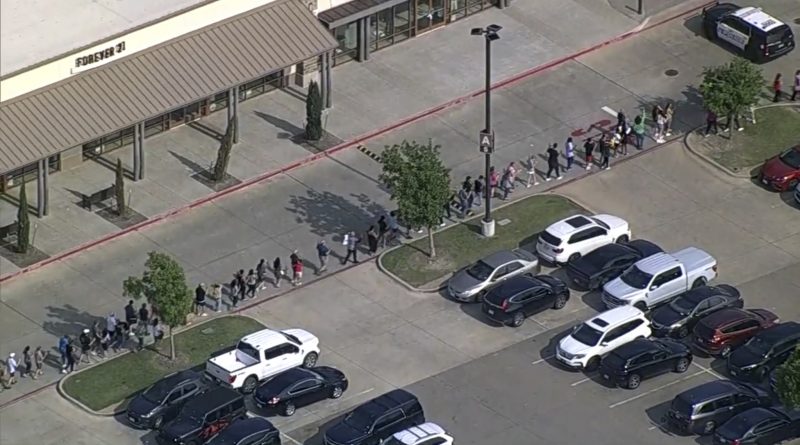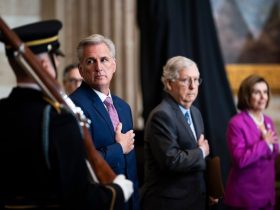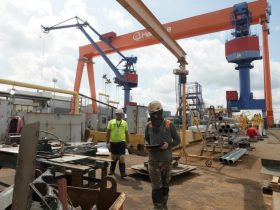The most conservative way to describe gun violence in the United States over the last two weeks is to say that 27 people have been shot to death in “mass killing” events.
This excludes a lot of other deaths from guns, some of which we’ll get to in a moment but others for which the toll is measured even more narrowly: people taking their own lives or any of the tens of thousands of other people otherwise killed by firearms each year in the United States.
It also excludes scores of people shot but not killed in mass killing events and in general.
It also excludes those who are the focus of this article: the hundreds of people who were present as gunmen opened fire in crowded public places. That toll is rarely considered, much less tallied, and while the effects of witnessing a shooting are not physically damaging, they nonetheless incur an avoidable cost.
The way we talk about gun violence often centers either on annual totals — blurring the personal effects in a “one death is a tragedy, but” sense — or on mass killing events. So let’s start there. The 27 deaths indicated above have occurred in five events, according to the Mass Killing Database maintained by Northeastern University, USA Today and the Associated Press.
In four of those five events, the death toll was the entirety of the damage. In the mass shooting at a mall outside Dallas this weekend, though, there were also seven people injured by the gunman.
As many Americans are by now aware, mass killing events are distinct from mass shooting ones, a bit of America-specific vernacular that differentiates between the number of people killed in a single incident of gun violence (generally four) and the number of people struck by bullets (also generally four, including those wounded). The latter necessarily includes the former but is more expansive.
Data from the Gun Violence Archive, which collects news reports of events in which at least four people are shot, indicates that there have been 36 such events in the past two weeks. Fifty-seven people have been killed — 30 of them in events where fewer than four people were shot to death.
Far more people have been injured in those events: 128, according to the Gun Violence Archive data. In total, 185 people have been killed or injured in these mass shooting events.
Again, this is in the last two weeks. The Mass Killing Database data indicate that 115 people have been killed so far this year in mass killing events. The Gun Violence Archive data indicate that 282 people have been killed in mass shooting events in 2023 and 1,100 people killed or injured.
Then there’s that other toll. Pictures and video from the mass shooting in Allen, Tex., showed hundreds of people leaving the mall after the shooting ended. There were multiple news stories of people hiding in the backs of stores or crouching behind counters as the violence was underway. It’s probably impossible to know how many people were there, heard the gunfire and had to evacuate.
In other such incidents, it’s easier to come up with an estimate. News reports after a shooting in Ocean Springs, Miss., indicate that there were about 200 people at the Scratch Kitchen when a gunman opened fire, wounding six people and killing one. In other events — unfolding at block parties, house parties, after-prom get-togethers — news reports offer estimates of how many people might have been affected.
Videos from other mass shootings give a sense of scale.
In Las Vegas, several dozen people scrambled to escape after gunfire erupted.
In Texas, people rushed to get into cars to escape.
VOLUME UP! This is the moment four men were shot in Downtown Bryan this morning.
I’ve just updated the story with new information here–> https://t.co/LxGz1gI3if
: Jazmine Chavez pic.twitter.com/2cP7eeCGAg
— Rusty Surette (@KBTXRusty) April 30, 2023
It’s probably impossible to know precisely how many people were present at similar events, but a review of news articles collected by the Gun Violence Archive indicates that, including the mall in Allen, a conservative estimate would suggest that more than 1,000 people were at mass shooting events even if they escaped without physical injury.
Local news reports about mass shooting incidents elevate this broader community concern more acutely.
“We know that our students who were at the party may be traumatized and in need of our support following this act of violence,” the principal of a Kentucky school wrote in a letter to families after a mass shooting unfolded at an after-prom party.
Nor do the effects stop with those present at the events. A mass shooting in a California home became the talk of the community.
“I’ve talked to everyone. In the grocery stores they’re talking about it, everyone at the Family Dollar, and even when I went to the gas station,” one woman told a local news outlet.
Those effects, too, are hard to tally.
There’s another commonality in the local news reports about mass shooting events: a sense of outrage and need for change. In article after article, reporters and residents articulate their frustration at gun violence seeming to be inevitable.
Those news reports are quickly pushed down the page on local news sites covering mass shooting events in: Adelanto, Calif.; Columbia, Mo.; Frostburg, Md.; St. Louis; Newark; Thornton, Calif.; Redwood City, Calif.; Chico, Calif.; Columbus, Ohio; Allen, Tex.; Robinsonville, Miss.; Natchez, Miss.; Bastrop, La.; Vicksburg, Miss.; Ocean Springs, Miss.; Chicago; Atlanta; Lake Wales, Fla.; Bossier City, La.; Lafayette, La.; Paducah, Ky.; Henryetta, Okla.; Oklahoma City; Las Vegas; Athens, Ga.; Bryan, Tex.; Mojave, Calif.; Bay St. Louis, Miss.; Lawrence, Mass.; Birmingham, Ala.; Columbia, S.C.; Auburn, Wash.; Philadelphia; and Cleveland, Tex.
In the last two weeks.








